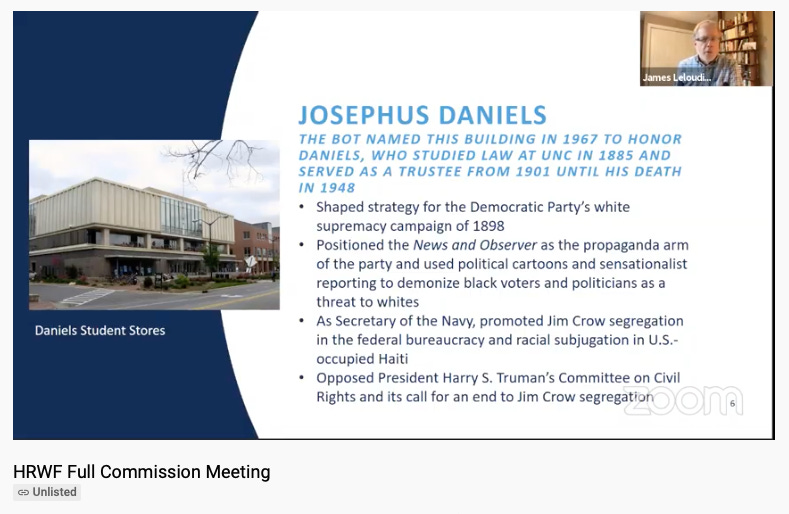
THIS WILL be one of those newsy editions of the newsletter.
UNC-Chapel Hill’s Board of Trustees meets Thursday at 11 a.m.* (Watch here, live or later.)
Last they met, in a June emergency session, the BOT ended the moratorium on renaming campus buildings. The vote (11-2) was not unanimous. Before the vote, there was some handwringing hidden behind the excuse that the decision shouldn’t be made in a videoconference meeting. (Like the entire world in the time of COVID-19, the board has been making important decisions remotely since March.)
One trustee even said of the students advocating for change: “… we don’t let the prisoners run the prison.” The prison being the University of North Carolina at Chapel Hill, and the change he opposed being lessening its link to white supremacy. Social media lit up, the meeting went into recess, and they returned with his apology for word choice.
In an environment where statues are coming down all over the country, Mississippi is changing its state flag, the Washington football team is losing its nickname, Harley-Davidson is backing Black Lives Matter, NASCAR is banning the Confederate flag, and the NFL is apologizing for opposing protests of police brutality, lifting the moratorium was the absolute least UNC could do. It had little choice.
The BOT had put the moratorium into place in 2015 as a sort of middle finger when they relented to pressure and changed the name of Saunders Hall, which honored the one-time leader of North Carolina’s Ku Klux Klan. They begrudgingly changed it to the bland Carolina Hall despite other meaningful suggestions. Three trustees still voted to keep the Saunders name. The parallel moratorium’s message was clear: UNC had no intention of further course correction, so quit asking.
Following the lifting of the moratorium, and with UNC realizing it had to keep up with current events, its Commission on History, Race, and a Way Forward (the commission formerly known as History, Race, and Reckoning) held its regular meeting last week. (It has a website with links to its meetings.)
The Commission unanimously put forth a resolution for UNC to immediately drop the white supremacist names of four campus buildings, with more to come. That recommendation went to the chancellor, who is expected to move it to the trustees, who are expected to vote on it Thursday.
The four buildings are Aycock Residence Hall, Carr Building, Josephus Daniels Building (Student Stores), and Ruffin Residence Hall. The recommendation includes thorough historical cases for each. These men’s names and likenesses have been coming down elsewhere in North Carolina. Here are the slides presented during the meeting that briefly summarize each.




A THEME that Sherick Hughes and other members pointed out from Commission co-chair James Leloudis’s presentation was that these men were not merely “men of their times,” as some like to say to defend enslavers and historical white supremacists. (You can’t judge them by today’s standards, etc.)
These men, as an example, were not just men of their times … they made their times. This is a crucial point. They were rich, powerful men in politics, government, industry, education, law, and media who used their weight to bend society to their values of oppression. And thus they shaped the times of generations who followed.
The men-of-their-times argument has always fallen short anyhow. Plenty of people in those same times knew the practices of their times were evil. Many fought against those practices. Support for slavery or white supremacy or secession weren’t even a monolith of white thought in North Carolina or the South. And of course, contemporary Black people well understood their evils.
That very recognition was at the center of many disputes as the wealthy leaders of this nation wrote its founding documents, and we are still paying the prices for the moral compromises the white men who drafted them made.
In related news last week, UNC’s history department — along with political science; sociology; and peace, war, and defense — announced they are taking it upon themselves to rename their home, Hamilton Hall, as Pauli Murray Hall. They started the process, not waiting for the slow-moving university to act.

Interestingly, that campus building that had already gotten a name change because it was named in 1922 for a KKK leader … 31 years after his death … was also home to the history department at its opening. And that’s not even delving into Kemp Plummer Battle’s role in the history department and in shaping UNC and Chapel Hill history. Who tells history, why, how, when … and where … matters.
That a UNC trustee is calling certain students, many Black, “prisoners” and the campus a “prison” during a public meeting — not in 1820 or 1920, but in 2020 — makes clear that to some white men and women “their time” never ends.
*UPDATE: The meeting is now at 11 a.m. Watch here.
SOURCES & CREDITS:
June 17 UNC Board of Trustees meeting: youtube.com
UNC Commission on History, Race, and a Way Forward: historyandrace.unc.edu
July 10 meeting of the Commission: youtube.com
Slides from Commission meeting: Screenshots from the meeting video
UNC Department of History announcement and building photo: history.unc.edu
Carolina Hall / Saunders Hall: carolinahallstory.unc.edu
Banner photograph and design: Mike Ogle



It takes a strong person to continue the fight.